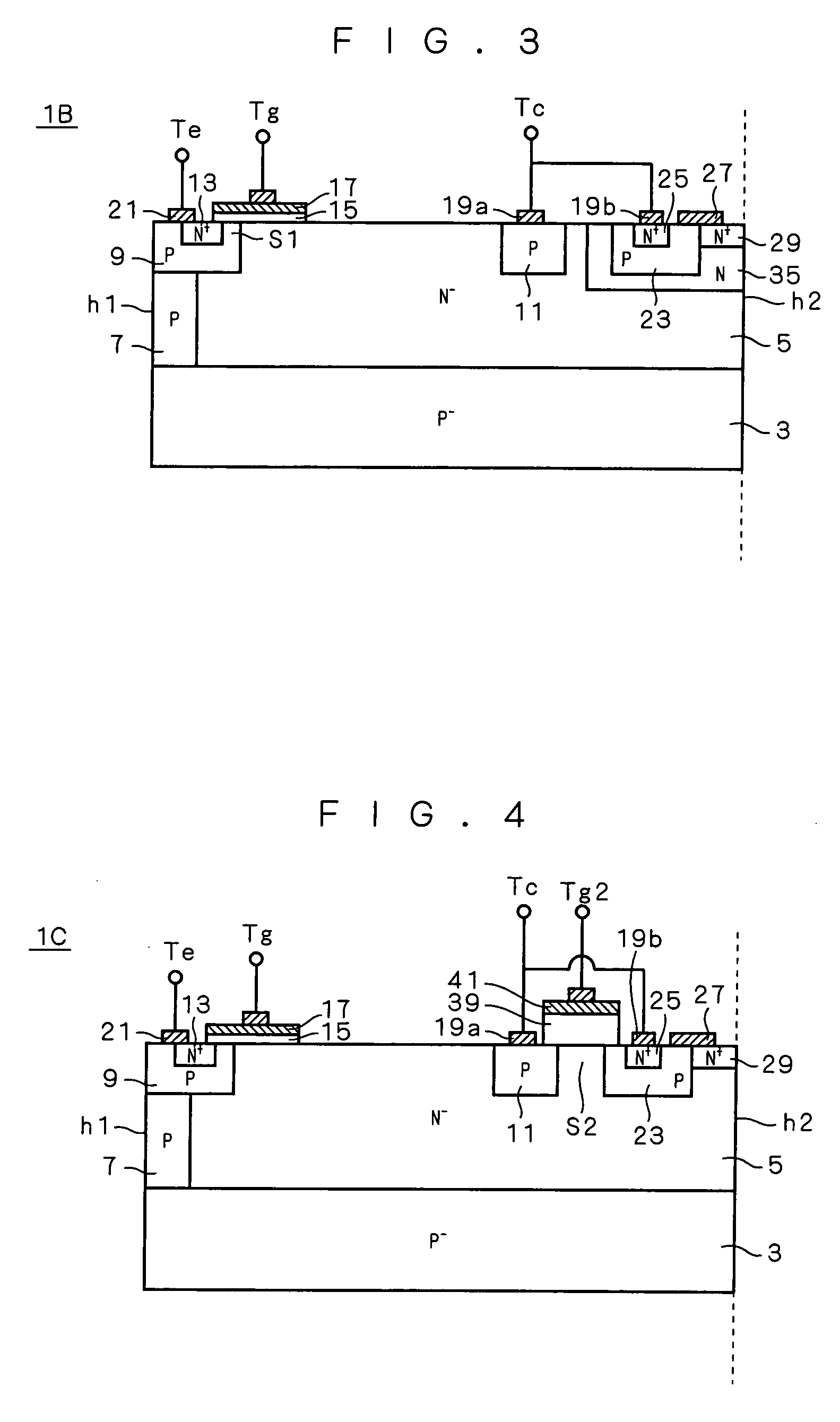Semiconductor device
a technology of semiconductor devices and diodes, applied in semiconductor devices, diodes, electrical apparatus, etc., can solve the problems of reducing the operating efficiency of the device, so as to achieve the effect of improving the operation
- Summary
- Abstract
- Description
- Claims
- Application Information
AI Technical Summary
Benefits of technology
Problems solved by technology
Method used
Image
Examples
first preferred embodiment
[0032] A semiconductor device 1A according to this preferred embodiment is a lateral collector-shorted IGBT. It includes, as shown in FIG. 1, a P− substrate 3 (semiconductor substrate of a first conductivity type); an N− epitaxial layer 5 (semiconductor layer of a second conductivity type) formed on one main surface of the P+ substrate 3; a P diffusion region 9 (first semiconductor region of the first conductivity type) formed in the surface of the N− epitaxial layer 5 and connected to the P+ substrate 3 through a P diffusion region 7 (semiconductor region of the first conductivity type); a P diffusion region 11 (second semiconductor region of the first conductivity type) formed in the surface of the N− epitaxial layer 5 apart from the P diffusion region 9; an N+ diffusion region 13 (third semiconductor region of the second conductivity type) formed in the surface of the P diffusion region 9 so as to be surrounded by the P diffusion region 9; a first gate electrode 17 provided on a ...
second preferred embodiment
[0048] A semiconductor device 1B according to this preferred embodiment is, as shown in FIG. 3, constructed such that in the aforementioned first preferred embodiment, an N diffusion region (semiconductor region of the second conductivity type) 35 having a higher carrier density than the N− epitaxial layer 5 is further formed between the N− epitaxial layer 5 (semiconductor layer) and the P diffusion region 23 (fourth semiconductor region) to surround the P diffusion region 23.
[0049] In the semiconductor device 1A of the aforementioned first preferred embodiment, with reference to FIGS. 1 and 2, the formation of the diode D1 consisting of the components 23 and 25 for reverse conduction in the N− epitaxial layer 5 creates a parasitic PNP transistor whose emitter, base, and collector are formed respectively of the components 11, 5, and 23 (a dotted line 55 in FIG. 2 indicates the collector of this parasitic PNP transistor). When the collector terminal Tc is at a higher potential than ...
third preferred embodiment
[0051] A semiconductor device 1C according to this preferred embodiment is, as shown in FIG. 4, constructed such that in the aforementioned first preferred embodiment, a second gate electrode 41 is further provided on a surface portion of the N− epitaxial layer 5 (semiconductor layer) which is sandwitched between the P diffusion regions 11 and 23 (second and fourth semiconductor regions), with a second gate insulating film 39 in between; and a second gate terminal Tg2 is connected to the second gate electrode 41. That is, this semiconductor device 1C is such that a P-channel MOSFET Q2 (see FIG. 5) whose drain and source are formed respectively of the P diffusion regions 11 and 23 is further added to the aforementioned first preferred embodiment.
[0052] Here, the second gate insulating film 39 is formed to approximately a thickness of field oxide film so that the semiconductor device 1C can withstand high voltage.
[0053] The equivalent circuit of the semiconductor device 1C is, as sh...
PUM
 Login to View More
Login to View More Abstract
Description
Claims
Application Information
 Login to View More
Login to View More - R&D
- Intellectual Property
- Life Sciences
- Materials
- Tech Scout
- Unparalleled Data Quality
- Higher Quality Content
- 60% Fewer Hallucinations
Browse by: Latest US Patents, China's latest patents, Technical Efficacy Thesaurus, Application Domain, Technology Topic, Popular Technical Reports.
© 2025 PatSnap. All rights reserved.Legal|Privacy policy|Modern Slavery Act Transparency Statement|Sitemap|About US| Contact US: help@patsnap.com



